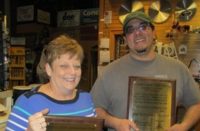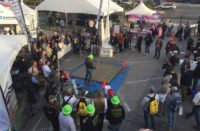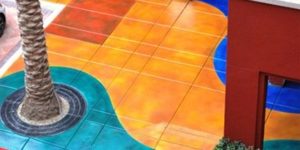How could we narrow down the numerous influential people in the industry to just 10? It wasn’t easy, that’s for sure. Our list is by no means all-inclusive, but here are brief profiles of 10 people we think continue to influence the decorative concrete industry in a positive way. Who should we have included? Sound off at our Facebook page.
 Larry Rowland – Lehigh White Cement Co.
Larry Rowland – Lehigh White Cement Co.
An accomplished educator with more than 25 years of experience in the material supply and construction industries, Larry Rowland is well versed on the topics of architectural, decorative and high-performance concrete, as well as concrete sustainability. The manager of marketing and technical services for Lehigh White Cement regularly speaks professionally on these topics to architects, engineers, students and green building enthusiasts.
You could say Rowland is a man of letters. He’s a Certified Construction Product Representative with the Construction Specifications Institute (CSI-CCPR) and he’s been a Leadership in Energy and Environmental Design Accredited Professional (LEED A.P.) with the U.S. Green Building Council since 2004. He chairs the American Concrete Institute’s Decorative Concrete and Plastering Committees, and has served in numerous capacities with the Concrete Joint Sustainability Initiative, the Portland Cement Association and the Architectural Precast Concrete Association.
In recent years Rowland has organized events and outreach programs on the topic of resilience between the concrete industry and national organizations such as the National Institute of Building Science and the Federal Alliance for Safe Housing.
Perhaps his most influential feat was chairing the ACI 310 committee which, along with his fellow committee members and ACI staff, produced the 45-page “310-R-13 Guide to Decorative Concrete” published in December 2013.
“It’s the most comprehensive guide of its kind,” Rowland says. “Its main purpose is to give guidance in non-mandatory language to designers and applicators about the materials and methods required to produce decorative concrete flatwork.” Before this booklet came out, a generic resource guide on many of the covered materials and methods did not exist.
The document is destined to become the reference guide for decorative concrete now and in the future as the work is tweaked and improved. The ACI 310 committee is currently working to develop a guide specification for concrete polishing and has a joint task group with ACI 308 to develop guidance for curing decorative concrete.
Members of the 310 committee single out Rowland for the successful fruition of the guide. “If there is one hero in this whole thing it’s Larry Rowland,” said the well-respected freelance writer Joe Nasvik, in 2013. “He spent a lot of time following through with developing documents and keeping the guide moving forward. If it weren’t for him, there wouldn’t be a document right now.”
www.lehighcement.com
 Tom Ralston – Tom Ralston Concrete
Tom Ralston – Tom Ralston Concrete
One of Tom Ralston’s most outstanding personality traits is his zealous desire to share his concrete revelations and discoveries.
For 25 years, the president of Tom Ralston Concrete in Santa Cruz, California, has conducted seminars and hands-on training events for such organizations as the American Society of Concrete Contractors Decorative Concrete Council, the American Institute of Architects and the National Ready Mix Association. His recognized expertise has led to consulting jobs and lucrative projects inside and outside the U.S.
Professional Trade Publications recognized Ralston’s outstanding contributions to the industry and passion for decorative concrete by inducting him into the Decorative Concrete Hall of Fame in 2011. At World of Concrete 2014, the third-generation concrete contractor was honored by Hanley Wood for presenting 19 decorative concrete-related seminars at WOC in seven years.
Ralston not only excels at public speaking but he’s also published two books: “Cast-in-Place Concrete Countertops” and “Sculpting Hillsides with Decorative Concrete,” both through Schiffer Publishing. Certified as a decorative concrete expert by the American Concrete Institute, Ralston has had his work featured on the covers of seven magazines and has been featured in architectural, design and trade publications, including Concrete Decor. His company has received eight top honors at WOC, including Best Decorative Concrete Project in 2012 and 2014.
A member of Cabrillo College’s Construction Management Board, Ralston conducts seminars at the college and will occasionally teach a concrete construction class at Chico State. “Teaching in and of itself has inherent rewards as it employs the principle, ‘in giving we receive.’ Add passion to the equation and there’s even more incentive to move in that direction,” says Ralston.
Through concrete work he’s created unique and beautiful things, traversed the world from Atlanta to Aruba and so many places in between, and been part of too many fantastic projects to describe.
“My experiences provide additional fuel for passion and make me even more inclined to share them,” he says. Although sometimes sensitive about sharing proprietary information with competitors, he usually does anyway. “If I am going to skate on the cutting edge of decorative concrete then what I did yesterday is not what I’m going to do today or tomorrow. I choose to believe that by giving away my thoughts and creations more will flow to me in abundance.”
www.tomralstonconcrete.com
 Mike Archambault – Moderne Méthode and Béton Academy
Mike Archambault – Moderne Méthode and Béton Academy
Installer, educator and Professional Trade Publications Hall of Famer, Mike Archambault spent the first phase of his career in Houston, Texas, where he owned Patterned Concrete of Houston and Patterned Concrete Industries and served as an active board and committee member for the American Society of Concrete Contractors and the American Concrete Institute. In Paris, France, since 1997, he continues to play an important role in the introduction of American decorative concrete materials and practices in Europe, the Middle East and Asia.
After selling his shares of his business in the mid-1990s, Archambault, 58, assisted a contractor in the United Kingdom, and worked on decorative concrete for Disneyland Resort Paris. He spent three years as a Paris-based consultant for L. M. Scofield Co. before partnering with a Frenchman, Frederic Ljung, in 2005 to form Moderne Méthode.
In 2010, Archambault and his partner created the concrete college Béton Academy, a government-recognized training center. The school teaches students about a wide range of decorative concrete products and tools and, as of 2015, works in conjunction with the French program Companions and Masters of Work, which is a centuries-old apprenticeship-type program that provides supported training.
“Working with an institution like this is incredible,” Archambault says. “We’re talking the elite and serious students only. Having the oldest trades school in the world that for centuries has taught traditional methods bring stamped concrete into their teaching programs is unbelievable. This will give credibility to our trade.”
Archambault spends the majority of his time coaching three young men who work for him at Moderne Méthode, although being diagnosed with an uncurable form of cancer in 2013 and undergoing chemotherapy treatment has slowed him down a little. His son, Jimmy, is following in his footsteps as a decorative concrete installer based in Bozeman, Montana.
www.moderne-methode.com
 Bob Harris – Decorative Concrete Institute and SSI
Bob Harris – Decorative Concrete Institute and SSI
Few people can legitimately say they grew up in the concrete trade but Professional Trade Publications Hall of Famer Bob Harris sure can. Now 52 and from Temple, Georgia, Harris is very proud of the fact that he is a third-generation concrete finisher with family originally from California.
“When my grandfather was alive he helped pour concrete on the Hoover Dam, which sparked my Dad’s interest who would later become a very successful concrete contractor. Dad had me out on jobsites when I was a little guy so I was able to learn my craft from old-school concrete finishers that helped define our industry.”
In the mid 1990s, after working six years supervising themed concrete installations on Disney properties, Harris became director of product training for a large materials manufacturer, where his role took him all over the world teaching a variety of decorative concrete applications. Harris and his wife, Lee Ann, started the Decorative Concrete Institute in 2001, where they conduct training in their state-of-the-art teaching facility and in locations around the world.
In 2009, he and his business partners introduced a new line of exceptionally realistic stamping tools called Paladiano — Wonders of the World, which has now been acquired by Brickform. The patterns replicate historic stone and rockwork, and were produced by making and refining molds at historic European locations.
Harris has written four books, produced several DVDs and written many articles for various trade journals and Internet sites over the years. Last year, Harris started a new chapter of his career by joining Structural Services Inc. as senior director of Decorative Concrete Consulting. “This is the most diverse and skilled group of consultants I’ve ever been involved with,” he says.
www.ssiteam.com
www.decorativeconcreteinstitute.com
 Darrel Adamson – Engrave-A-Crete
Darrel Adamson – Engrave-A-Crete
Before Darrel Adamson came along, concrete engraving was not in the industry’s vernacular. The founder and CEO of Engrave-A-Crete first envisioned engraved concrete back in 1988. It just made sense to him, both economically and environmentally, to transform existing concrete by cutting patterns into it to make it more aesthetically pleasing rather than tearing it up and starting over from scratch.
By combining his expertise in concrete sawing and drilling with his knowledge of decorative concrete, he designed his first prototype engraving tool somewhere around 1990 and coined the term “engraved concrete.” In 1992, he sold his first tool at World of Concrete, and later that year founded Engrave-A-Crete in Florida. Back then, Adamson operated from his garage, as many fledgling businesses do, and his first gig involved engraving a brick pattern on a driveway.
Today, the company owns an 85,000-square-foot facility in Mansfield, Missouri, and manufactures an impressive line of quality decorative concrete engraving tools and products used worldwide to enhance existing concrete and make it look like everything from brick and cobblestone to marble tile and intricate designs. Adamson and his son, Brandon, offer hands-on training not only in engraving but also in staining, layout and marketing.
One of the first tools he developed back in the ’90s, the Super Compact Cobra, is still among the company’s most popular. To date, Adamson holds five patents, as well as numerous copyrights and trademarked items. The inventor, researcher, developer, designer and overall always-thinking man is far from done when it comes to making contributions to improve the industry.
Numerous projects are in development, he says, like novel processes for coloring slabs. And, there’s always a cutting tool being created or enhanced for more speed and agility.
“Vertical concrete engraving is nearly untouched,” Adamson says, “so we’re developing methods to make concrete walls into pictorial themes or simply making them look like brick.” Undulating brick patterns are very difficult for masons, he adds, and engraving will make them easier to produce.
www.engraveacrete.com
 Byron Klemaske II – T.B. Penick & Sons Inc.
Byron Klemaske II – T.B. Penick & Sons Inc.
When people seek advice concerning the decorative concrete industry, they often turn to Byron Klemaske II, a widely recognized authority and innovator in the business with more than four decades of experience to his credit.
The executive vice president of T.B. Penick & Sons began his decorative concrete trek back in the early ’70s when he was just 17 years old and became intrigued with something called the “Bomanite process” used by his San Diego employer, John T. Dryden Inc. Concrete imprinting soon became his forte, as Klemaske developed products, tools, methods, finishes and markets that propelled the decorative concrete industry forward.
By 1987, Klemaske and his two brothers formed Klemaske Brothers Concrete and built a solid reputation for installing architectural concrete throughout Southern California. In the mid- to late ’90s, he worked for Progressive Concrete in Escondido and was largely involved in developing Micro-Top, a troweled-on cementitious topping now made by Bomanite, and Arte Povera, a system using reactive stain.
In 1999, Tim Penick of T.B. Penick & Sons approached Klemaske about joining his company and heading up the firm’s Innovative Concrete Group. He joined as vice present of operations, assembling a world-class team of decorative concrete artisans, including his brothers, wife and other family members. Today, Penick, founded 110 years ago, is heralded as a leader in the decorative concrete industry.
Klemaske continues to contribute to the betterment of the decorative concrete trade. In recent years, he helped Penick secure a patent for a system called Pervious Concrete Elements. On a personal level, he was inducted into the Decorative Concrete Hall of Fame in 2013.
“The decorative concrete industry has provided my family members and me a very rewarding life and livelihood,” Klemaske says. “I still enjoy being a part of the collaborative and brainstorming process to come up with solutions to build new projects while using learned techniques as well as new and innovative thinking processes. It’s been a fulfilling four decades!”
www.tbpenick.com
 FuTung Cheng – Cheng Design
FuTung Cheng – Cheng Design
Known far and wide for his sophisticated residential design and innovative use of a wide variety of materials in homes, FuTung Cheng of Berkeley, California, is an award-winning designer and acclaimed author who consistently breathes new life into decorative concrete applications.
A graduate of the University of California at Berkley with a degree in fine arts, he founded Cheng Design in 1986, followed by Cheng Products in 1998 and Cheng Concrete in 2004. He and his design team incorporate elements of nature and organic textures, creating contemporary designs oozing with creativity, details and fine craftsmanship.
From among nearly 1,000 entries, Cheng Design received one of three Gold in Residential Architecture awards in 2014 in the seventh annual International Design Awards competition. He’s one of the few non-architects to receive design awards from the American Institute of Architects. He’s been inducted into the Decorative Concrete Hall of Fame and the National Kitchen & Bath Association Hall of Fame, and named one of the Top 50 Most Influential in 50 years by Kitchen & Bath Business magazine.
Cheng has taught more than 5,000 contractors, do-it-yourselfers and artisans the craft of concrete countertop-making. More than 250,000 copies of his three books on countertops, design and concrete applications have been sold and are part of his pioneering movement to inspire the hands-on creativity of others.
Cheng says his latest innovation, ShapeCrete, a high-performance, easily shapeable concrete, “makes it easy for the broadest possible audience to realize their own potential for play and creativity with concrete.” This summer it will be available in thousands of home improvement stores nationwide.
“We were created to be part of nature and our nature is to be creative,” says Cheng. “Nature tirelessly creates daisy chains of great design. And she does so across time, across galaxies, across continents, and across the street. Nothing too large, or too small, escapes her full attention to exquisite detail. We are woven into the web of the tapestry of creation. And one by one, we are born to have our own turn at the loom.”
www.chengdesign.com
 Alise Martiny – Greater Kansas City Building and Construction Trades Council and MAGIC (Mentoring a Girl in Construction)
Alise Martiny – Greater Kansas City Building and Construction Trades Council and MAGIC (Mentoring a Girl in Construction)
Alise Martiny has worked in the construction industry for more than 35 years, all the while actively recruiting women and minorities into the trade. She currently serves on several community projects in the Kansas City, Missouri, area and has held several positions which include serving on her union’s executive board and holding the post of vice president. She is currently president of her local union and founded MAGIC (Mentoring a Girl in Construction).
Through MAGIC, journey-level tradeswomen teach safety, carpentry, concrete, masonry, electrical, plumbing and welding skills during a week-long camp. At the program’s conclusion participants take home tools, a toolbox and other projects they make. The students participate in a field trip to an active construction site to see how the skills they are studying are implemented in the field.
“This program is unique because it partners with local construction businesses and industry associations with one goal…to introduce high school girls to the opportunities available to them in the construction industry,” says Martiny.
Although Martiny has many years in the concrete industry, her passion became decorative concrete after attending a conference sponsored by Bomanite in the early 1980s. “When I first got started in the decorative side of the industry, the stamps were made out of metal and we didn’t have very many options with colors,” she says. “It has been amazing to see how much technology has changed with all the textured and staining options. What used to be an expensive addition to a regular gray slab of concrete is really affordable today.”
www.buildkc.org
www.mentoringagirlinconstruction.com
 Mike Murray – Concrete Cares
Mike Murray – Concrete Cares
Mike Murray, 67, began his career as a concrete finisher in 1964. In 1979 he opened Murray Concrete, a concrete contracting company in the Kansas City, Missouri, area. Later, he began installing stamped concrete, which led him to open Murray Decorative Concrete Supply with his wife, Donna.
In July 2014 the Murrays passed the company torch to ChemSystems Holdings, and the couple opened a consulting firm. They turned much of their attention to Concrete Cares, a foundation Mike started three years ago to raise awareness of cancer. For their first project, they donated a concrete patio with the pink ribbon logo to a Hope Lodge in Kansas City, which provides free lodging for cancer patients.
“Concrete Cares was founded not to make money or be well known but to start programs in local communities to help those afflicted by cancer,” Murray says. “We wish to get students and groups such as Boy Scouts and Girl Scouts involved. We also hope some communities can leave behind concrete projects that can be seen, walked and driven on daily. We want funds raised in one area to stay in that area for local needs.”
Murray is trying to build Concrete Cares to be active in all 50 states. So far, for instance, the organization’s work in Nebraska has raised about $20,000 to help cancer patients. To date they’ve completed projects in Nebraska, New Mexico, Arizona, South Dakota, North Carolina, Nevada, Kansas and Missouri. They have presented programs in several states and did a slab for World of Concrete 2012. Many individuals and companies in the industry are contributing to the efforts and Concrete Cares works with local ready-mix suppliers to display pink trucks at events.
Murray is an ACI Fellow and says he’s always been a believer in industry certifications, currently holding six certifications himself. He’s still active in training. “We want to raise the bar on residential and decorative concrete so it not only looks pretty but withstands durability issues,” he says. “I still feel I’ve got a lot of good years in me and I want to reach the guys on the smaller scale to make sure they’re doing quality concrete.”
www.concretecares.com
 John Abrahamson – SASE Co.
John Abrahamson – SASE Co.
John Abrahamson has been with SASE since December 2009, and currently serves as the vice president of operations, working out of Knoxville in a 22,000-square-foot facility that is in the process of having its size doubled.
Abrahamson grew up in the flooring industry and, until the year 1999, served as a regional vice president in charge of 28 retail stores and as president of a commercial contract flooring facility, among other things, for Shaw Industries, a Fortune 200 Company.
Prior to joining SASE, Abrahamson was president of HTC in the U.S.. Before Abrahamson’s involvement, HTC only sold through distributors. VIC International had been selling HTC machines for a couple of years with limited success penetrating the U.S. market.
“I simply turned to what I knew,” Abrahamson recalls. “I drew upon my experience in flooring and marketed a floor system and offered a flooring solution instead of peddling a machine for prep and maintenance. I had a small, but strong, staff at VIC, and support from the owner, Vic Green. We started holding training seminars at VIC because we literally had to teach people what polished concrete was before we could teach them the process of polishing concrete and sell them anything. We achieved a great deal of growth in a very short span of time.”
Later, in 2004, after growing sales in the U.S. from under $200,000 a year to nearly $7 million a year, Abrahamson helped HTC form a company and take the product line direct in the U.S. The company had tremendous growth over the next 3 1/2 years, then sold to an investment company.
After selling his shares in HTC in 2007, Abrahamson honored his non-compete, then joined SASE. “The best adventure of my career is still before me,” he says. “SASE is now far and away the leading supplier of polished concrete equipment and tooling. We have a great leader in Jim Weder, the majority owner, president and CEO of SASE. He understands the need to manage down first and up second, so SASE management can focus first on the customer, then on the employees, then, thirdly, on answering to ownership. This has always been my philosophy, and one of the reasons I am so confident that SASE has a bright future.”
www.sasecompany.com















